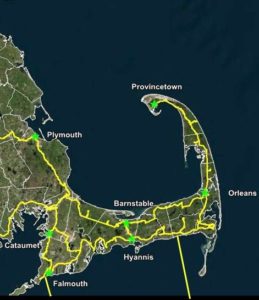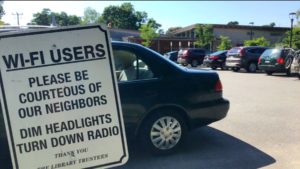PROVINCETOWN — The OpenCape fiber optic cable network went live in January 2013, having secured $40 million in grants and offering the promise of high-speed internet connections to Cape Cod residents from the canal to Provincetown.
Six and a half years later, mention OpenCape to almost anyone here and the reaction is “Whatever happened with that?”

The nonprofit OpenCape Corporation’s own online autobiography, titled “The Vision Becomes Reality,” describes how in 2006, when local leaders met to address the region’s communications needs, “our businesses and research institutions were finding it increasingly hard to compete globally due to the high cost and poor availability of broadband. Each year we were losing thousands of talented workers who sought better jobs elsewhere.”
Not a lot has changed since then. Despite the fact that it is a regionally owned resource, OpenCape broadband isn’t an option for most Cape Cod businesses or residents — including the vast majority of those on the Outer Cape.
“I get people’s frustration,” said Steven Johnston, OpenCape’s CEO. Claiming that OpenCape’s phones ring off the hook whenever local internet and cable providers have a lapse in service, Johnston pleads for patience: “It may not seem it, but there is a plan in place that we’re trying to execute.”
OpenCape’s “plan,” in fact, is for others, not OpenCape, to make it happen. The “Residential Opportunities” page on the corporate website says that bringing broadband to homes “will require a combined effort of towns, businesses and residents.” But at a cost of $70,000 to lay a single mile of fiber, it could take years — even decades — for the existing network to be connected to a majority of homes or workplaces.
A major economic downturn may seem an odd time to begin a costly, technologically challenging project, but OpenCape might not have come together if not for the Great Recession of 2008. Part of the Obama administration’s efforts to stimulate the economy, the Broadband Technology Opportunities Program (BTOP) was created to help rural communities expand access to the internet. OpenCape secured a $32 million BTOP grant, with an additional $5 million promised by the commonwealth.
BTOP monies were designated to build “middle mile” fiber — like a backbone from which branches can extend like ribs. In Route 6, the Cape had a perfect existing path to follow, and OpenCape’s middle mile was built on schedule and on budget. But five years after completion of the basic network, those lateral offshoots — called “last mile” — are few and far between.
The federal grant had an expiration date, meaning work had to begin quickly. “With a little more planning, things could have been done differently,” said Teresa Martin, another OpenCape founder who now heads Lower Cape Community Access TV. “For example, there are certain points where you can cut into a fiber and run laterals from, and the places where those are located aren’t necessarily where you would pick to serve your population, or to serve your business community.”
To anchor the network, each town identified several local institutions to be connected to the middle miles of fiber — usually municipal or emergency services. “The entities that rely on data connectivity are the ones we’ve been connecting first: the hospitals, the banks, the schools, the towns,” Johnston said. “That’s the critical mass that makes the network sustainable. Now we’re expanding beyond that.”
Outer Cape residential pilot is on hold
According to Johnston, OpenCape is in the process of launching two residential pilot programs. “One of them is a downtown area that’s mixed density,” he said. “The other one is a multiple dwelling unit that has commercial as well as residential.” He won’t reveal the locations of these trials, but laments that a third — the only one planned for the Outer Cape — had to be put on hold; he would not say why.
“The national average to connect a home to fiber is about $2,500,” Johnston said. “For a town that has 1,000 homes, you’ve got to come up with $2.5 million.”
The easiest way to bring that number down? The Costco method: buy in bulk. If you signed up the whole town at once, he suggested, the per-home cost could be as little as $800.
“Then you’re only talking $800,000,” he said. “We know how many homes are in each town, so you can just do the math.”
To help residents crunch the numbers, Johnston said, OpenCape is creating a downloadable “toolkit” that offers strategies to help make FTTH — “fiber to the home” — a reality.
“One of them is talking to their town managers and their select board about what broadband means financially,” he said. “And working with their cable committee to understand why it’s important for the town.” By giving citizens the knowledge to take the case directly to local officials, he hopes to avoid a repeat of “The One That Got Away.”

“The town of Eastham should have been the first,” Johnston insisted, “because they built out water to every home. I called the town and said, ‘I don’t know where you are on your water project, but if you’re digging these trenches, we should add fiber to every house now.’ ” But he could not convince town management that the two public works projects could be completed in tandem, he said.
“You’re talking pennies on the dollar to put in a piece of conduit and run fiber to every home in town while you were digging up half of Eastham,” Johnston said sadly. “It’s a tragic missed opportunity because they could have easily been the most connected town on the Cape. Easily.”
In March 2018, Eastham may have wished it could rethink its decision, after a trifecta of nor’easters knocked out power to much of the Outer Cape and the Eastham Public Library’s broadband service via OpenCape became a lifeline.
“Everything was down. It was unbelievable,” said Debra DeJonker-Berry, director of the library. “The high school was supposed to be the shelter, but their generator didn’t work.” So the library became a port in the storm, offering not only warmth and safety but also the means to reach out to loved ones, contact employers and schools, and connect with the world at large.
“It was a test that we didn’t expect, and I feel like we passed with flying colors,” added Melanie Fernandes, Eastham’s access and technology services librarian. With most of the town cut off from power, telephone, and cable service, it seemed nothing short of a miracle that the library’s internet was up and running strong. “We got immediate feedback from people,” Fernandes said, “how appreciative they were.”
That level of connectivity would not have been possible in the former library building where, DeJonker-Berry said, “Many days you’d have only so many connections before patrons would get frozen out.” Fortunately, the new building was designated a “community anchor” and wired into OpenCape’s network during construction.
Connecting to Outer Cape beaches
Another misfortune, just a few months later and a few miles north, was a somber reminder of the inadequacy of cell-phone coverage on the Outer Cape, even at some of its most heavily trafficked locations.
The fatal shark attack at Newcomb Hollow Beach in Wellfleet on Sept. 15, 2018 led to renewed calls to increase connectivity on Outer Cape beaches. “I feel hopeful about the public safety conversations over the winter, driven by the shark issue,” said Martin. Johnston said OpenCape proposed wiring 12 beaches for $1.2 million, offering to donate bandwidth for shark detection or study.
Connecting beaches to OpenCape’s middle-mile network may offer satellite benefits. “When I look at running fiber,” said Johnston, “to the National Seashore in Wellfleet, where there’s maybe six houses out there in one area and it takes me three miles to get to them, you can imagine the economics of that are really not attractive.”
“Last-mile” fiber lines, running laterally from OpenCape’s main network to the shore, could help bridge the gap to those remote homes. Until that becomes a reality, Johnston said, Provincetown is the Outer Cape locale where broadband development would be easiest.
“Provincetown is very much of interest to me because it is our Manhattan; it’s incredibly dense,” he said. “Most towns on the Cape have between 30 and 40 homes per road mile. Provincetown has 265 homes per street mile.”
Shared workspace becomes film production hub
Provincetown Commons, a new shared workspace on Bradford Street in the old Community Center that opened in February 2019, was able to reap the benefits of its proximity to the town’s police station. According to Executive Director Jill Stauffer, a high-speed connection was a must for the Commons’ clientele.
“We have lawyers, magazine editors, people that do medical billing,” she said. “We have entrepreneurs, a couple of people that run businesses from town.” In fact, without OpenCape the Commons and the town might have missed out on a major boost to Provincetown’s economy: the on-location filming of the Starz Network miniseries “Hightown” in June.
“We were a production hub for them,” said Stauffer. “They set up an accounting office, and the gal that organized the extras, and their main production office was here for a couple of weeks.” Initially Stauffer wasn’t sure the Commons could accommodate the bandwidths needed to transfer the massive media files of high-definition television production.
“I said, ‘Hey, I’ve got people in town that are going to be uploading Technicolor film to L.A.’ ” said Stauffer. “And Steve opened the pipe up for us, complimentary, for a week.”
So when will residential customers get to enjoy this kind of service?
“In a perfect world,” Johnston said, “five years from now every town on Cape Cod will have their own fiber network plugged into OpenCape.”
The Provincetown Commons and Eastham library experiences show the promise of OpenCape. But it’s one that residents and businesspeople dissatisfied with Comcast or Verizon DSL internet can still only dream about.
Editor’s note: Because of a reporting error, an earlier version of this article referred to Steven Johnston as a founder of OpenCape. He was not a founder, but has worked for the nonprofit for three and a half years.



